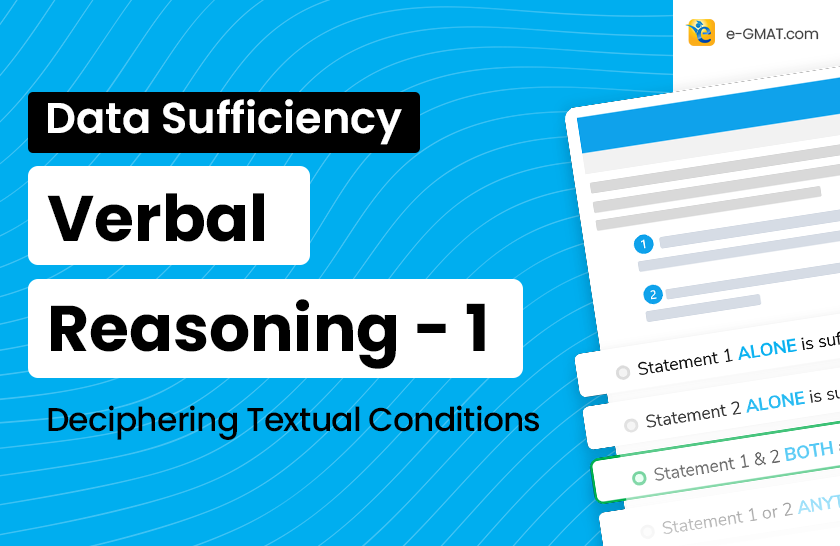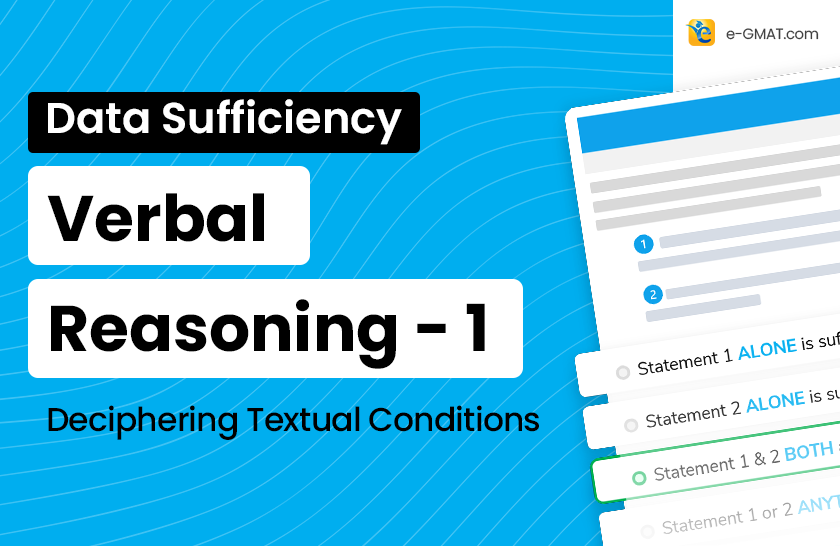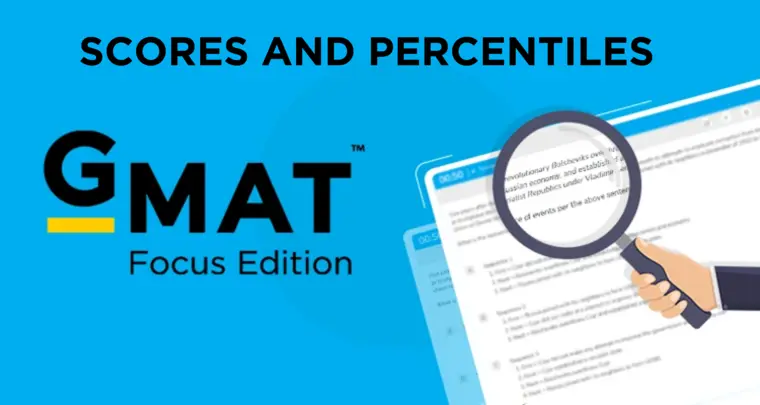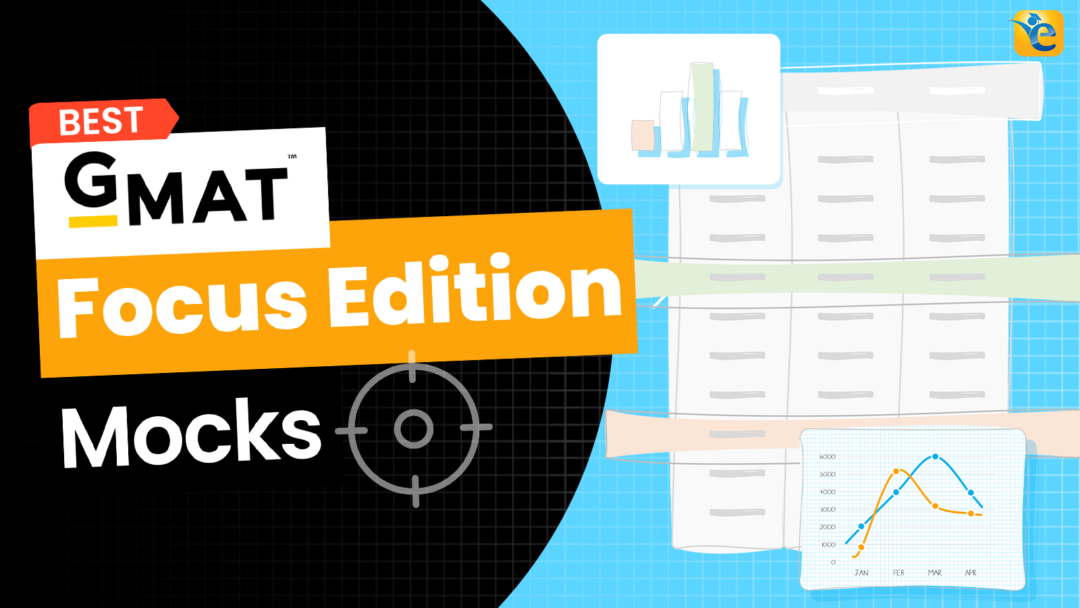Introduction
In our previous article, we explored the new landscape of Data Sufficiency (DS) questions in the GMAT Focus Edition, particularly focusing on their shift towards real-world scenarios and the addition of Verbal Reasoning. Now, it’s time to dive deeper into the Verbal Reasoning questions themselves.
In this article series, we will break down three official difficult brand-new verbal reasoning DS questions, showing you the variety they come in with and more importantly, how the skills we discussed earlier can be applied to solve them.
Our goal here is to give you the tools and understanding needed to confidently tackle any Verbal Reasoning question you encounter in the GMAT.

Let’s get started.
Be ready to solve ONE HARD Official Verbal Reasoning question and then solve two additional versions of the question to solidify the process.
Start your GMAT Focus journey with our free GMAT Focus mock test to gauge your baseline score, and then create a personalized study plan. Dive into our free trial for targeted prep. Trusted by thousands with 2600+ reviews on GMAT Club, e-GMAT is your partner in mastering the GMAT. Contact us at support@e-gmat.com for expert guidance.
The Variety
We will discuss three varieties of verbal questions in this article.
- Conditions applied to textual information.
- Conditions applied to tabulated data.
- Comparative analysis.
Let’s take each variety one by one, but before that, let’s recap the process that we will use to solve each of them.
Process to be used to solve these questions
Regardless of the type of verbal reasoning DS question, we should always use the following process:
- Own the dataset.
- Visualize the approach to answer the question asked.
- Execute the approach using the DS solution framework.
Let’s see this process in action for each variety of questions one by one. In this article, we will take up one variety. And in the next set of articles, we will take up the other two varieties.
Conditions Applied on Textual Information
Question
Here is a Difficult 645+ Level Official question.
Last summer, as with every summer, Oshin and Reena made exactly one long trip together to a town neither of them had visited before. For their long summer trips, Oshin and Reena have always chosen to visit a town that Reena would have liked to visit—unless Oshin had been to that town before. Reena had visited Town F and Town G before—and Oshin had never visited Town J or Town K. Did Oshin and Reena visit one of these four towns last summer?
(1) Reena had never visited Town J and Oshin had never visited Town F.
(2) Oshin would have liked to visit either Town G or Town K.
Step 1: Own the dataset
Translate the dataset
This step requires careful reading of the passage one part at a time and converting the passage into your own notes with the intent to “own the dataset” to such a degree that you do not need to refer to the passage while evaluating the statements.
So, if while solving such questions, when you are evaluating the statements, you see yourself going back to the passage, then that is an indication that you need to work on this skill set.
This passage presents two conditions for “town for last summer trip.”
- Town = not visited before by O and R
- Selection of Town
- R wishes
- O not visited
The passage presents information about four towns.
- R visited F, G
- O not visited J, K
The question asks – Did they visit F or G or J or K?
The above is the translation of the passage in your own words. So, is this sufficient to move forward with the statements? No. Absolutely not. We need to draw inferences at this stage to thoroughly own the dataset and visualize the approach more clearly.
Watch this video to see this treatment of the above question in the video format:
Draw Inferences
See, we have four towns in consideration. Let’s look at each one by one.
- F – Since R has visited it, F cannot be the town they visited last summer.
- G – Since R has visited it, F cannot be the town they visited last summer.
- J and K – O has not visited them, so these could very well be in the running.
So, we know for sure that they did not go to F or G.
So, you can see that by drawing this inference, we were now able to shortlist 2 candidates from 4 candidates. Now, we move to step 2, which is to visualize the approach to assess the individual statements.
Step 2: Visualize the Approach
To answer the question asked, we need to find out if they went to J or K. For this, we need the following information:
- R wishes – J/K
- R visiting history – J/K
We can tabulate this for easy processing:
| J | K | |
| R wish? | ||
| R not visited? |
As we assess each statement, if we get a clear answer about R’s wishes and R’s visiting history, we will be able to answer the question asked.
So, with this information, we are ready to move to step 3.
Step 3: Execute the approach
Analyze Statement 1:
Reena had never visited Town J, and Oshin had never visited Town F.
| J | K | |
| R wish? | ? | |
| R not visited? | yes |
Observe carefully how only one part of the statement was beneficial for our assessment – as it pertains to Reena’s visiting history. Oshin’s visiting history about town F is inconsequential since we already rejected town F. Such is the power of careful analysis and drawing inferences at optimum points in the solution.
Thus, this statement is not sufficient, and hence, choices A and D are eliminated.
Analyze Statement 2
Oshin would have liked to visit either Town G or Town K.
Let’s fill the table:
| J | K | |
| R wish? | ||
| R not visited? |
Nothing can be filled since we do not care about what Oshin would have liked to visit. It’s only Reena’s wishes that count.
Thus, Statement 2 is also not sufficient.
Hence, choice B is also eliminated, and we are left with choices C and E.
Analyze statements 1 and 2 together.
Even together, they are not sufficient since statement 2 did not bring anything to the table, literally and figuratively.
Thus, the correct answer is choice E.
Summary
Let’s summarize the salient features of this question.
- Question
- Conditions given for the selection of town.
- Textual information given about the four towns.
- Our approach
- Extracted the passage in our notes
- Drew inferences before adding any new information
- Visualized the approach and created a framework to assess the statements
- Executed the DS approach
- Observations
- We did not refer to the passage once we took notes.
- We were able to sift through irrelevant information because we had a solid framework to assess the choices.
Now, apply these learnings to these practice questions that are different versions of this official question.
Where are these skills taught in the e-GMAT course?
We teach you these skills in a progressive architecture in a specially created Data Sufficiency course. After learning the basics of Data Sufficiency questions, students further hone their process by solving quant-based Data Sufficiency questions, and then they start the verbal reasoning module.

Want to know where you stand on the GMAT Focus? Take our free GFE mock test and identify your baseline score. Get valuable insights into your performance, identify your strengths and weaknesses, and make an informed decision about your preparation path.
Practice Questions
Version 1: Statement 2 has changed. Everything else is the same.
Last summer, as with every summer, Oshin and Reena made exactly one long trip together to a town neither of them had visited before. For their long summer trips, Oshin and Reena have always chosen to visit a town that Reena would have liked to visit—unless Oshin had been to that town before. Reena had visited Town F and Town G before—and Oshin had never visited Town J or Town K. Did Oshin and Reena visit one of these four towns last summer?
(1) Reena had never visited Town J, and Oshin had never visited Town F.
(2) Reena would have liked to visit either Town J or Town K.
Version 2: All parts of the question have been modified
Last summer, as with every summer, Oshin and Reena made exactly one long trip together. However, unlike previous years, this time, they decided to visit a town that was recommended by their close friends and that either Oshin or Reena, but not both, had visited before. Did Oshin and Reena visit one of these four towns last summer? Oshin had visited Town F and Town G before, while Reena had never visited Town J or Town K.
(1) Among the towns recommended by their friends were Town F and Town J.
(2) Reena prefers visiting towns that Oshin has already explored to have a familiar guide.
Click here to get the Solution hints for the above questions.
Next in this article series
In the next article, we will explore the second version of Data Sufficiency verbal reasoning questions that test – “Conditions applied to tabulated data.”
Stay tuned!
- Data Sufficiency Verbal Reasoning 2 – Navigating Conditions in Tabulated Data
- Data Sufficiency Verbal Reasoning 3 – Exploring Comparisons
Ready to tackle the GMAT Focus Edition? e-GMAT offers a Personalized Study Planner and top-notch Free GFE mock exam to help you prepare effectively. As the most reviewed GMAT prep company on GMAT Club with 2600+ reviews we’re here to support your GMAT Focus journey. Take advantage of our free trial with the best quality content. Start your path to success today!













